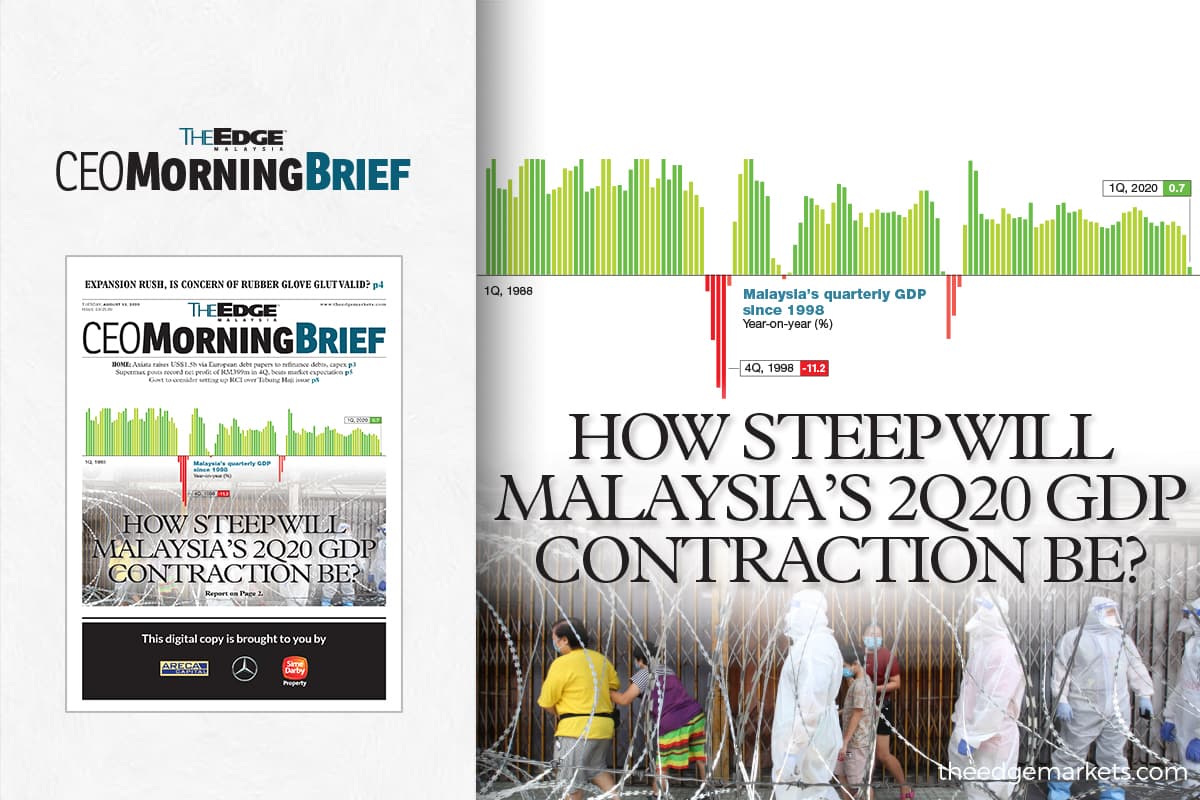
KUALA LUMPUR (Aug 11): Given the unprecedented Movement Control Order (MCO) to contain the Covid-19 outbreak, it is a foregone conclusion that Bank Negara Malaysia (BNM) will be announcing a contraction of gross domestic product (GDP) in the second quarter of 2020 (2Q20) on coming Friday.
It is certainly not a question of if but how steep the contraction was in 2Q20. Economists contacted by The Edge are projecting a double-digit contraction for Malaysia, adding that 2Q20 would be the trough for GDP.
The most recent time that Malaysia experienced GDP contraction was the first three quarters of 2009 during the global financial crisis. The country recorded a contraction of -5.8% in 1Q09. (see chart)
China is probably a handful of few that achieved economic growth in 2Q20. The world's second largest economy grew 3.2% while most countries reported a double-digit contraction. Singapore's economy shrank by -12.6%, the Philippines' GDP plummeted -16.5% while Indonesia's was down -5.3%.
RHB Research Institute chief Asean economist Peck Boon Soon said a contraction was inevitable due to the MCO. He expects 2Q20 GDP contraction to be -15%, worse than the -11.2% in 4Q98 during the Asian financial crisis.
Peck, however, expects the figure to gradually improve in the second half of 2020 (2H20). "Already, a rebound in exports was seen in June due to the further easing of movement control not just in Malaysia, but also overseas," he said.
Commenting on the likelihood of another rate cut, Peck said: "We believe BNM is done with its rate cut as economic conditions are gradually improving and too low an interest rate may result in unintended consequences such as encouraging speculation and building of bubbles where BNM is trying to avoid."
UOB Malaysia senior economist Julia Goh has revised her 2Q20 GDP estimate to -18%, from the initial -12%, following yesterday's release of the service index by the Department of Statistics Malaysia.
"The sharper contraction in 2Q20 [was] attributed to weakness in overall services index, which fell -21.5% year-on-year (y-o-y), construction work done that declined -45% y-o-y in 2Q20, manufacturing output which fell -18.1% y-o-y and mining production that declined 19.6% y-o-y," said Goh, adding that the only sector that is likely to support overall GDP would be agriculture, thanks to the 7.4% increase in crude palm oil production.
Assuming that the economic recovery sustains, and infection rates remain manageable in 2H20, Goh is maintaining her view that the GDP was to see through in 2Q20.
On the overnight policy rate (OPR), Goh has pencilled in a 25 basis points' (bps) rate cut at BNM's next Monetary Policy Committee meeting on Sept 10.
The central bank slashed the OPR by 25bps to a record low of 1.75% on July 7. So far, the central bank has cut a total of 125bps this year.
AmBank chief economist and head of research Dr Anthony Dass is expecting the domestic economy to shrink between -10% and -11%.
"Impact from the lockdown and MCO resulted in the disruption of supply chain and consumption, which is unprecedented and driven by the health crisis. It dragged down the economy severely," said Anthony.
But he noted that the relaxation of the lockdown and MCO, added with the fiscal stimulus as well as monetary measures, somewhat contained the downside. "That's also because commodity prices are fairly stable and supported by E&E (electrical and electronics)," he said.
"Thus, supported by these measures there has been some pickup in business activities and consumer spending, as reflected by indicators like Purchasing Managers' Index, labour market and industrial production," he added.
Anthony sees room for another OPR cut as early as September, as the downside risk on the economy remains high, driven by the fear of a second wave of Covid-19 infections as well as ongoing external issues plus domestic challenges.
"While a 25bps cut is fully factored [in], there is also room for a 50bps cut. While the current numbers are shedding some positive tone, with the moratorium ending and replaced with targeted help, plus the ending of wage subsidy, stronger ringgit as well as the need to support growth, [it] does permit a bigger-than-25bps cut i.e. 50bps," said Anthony.

